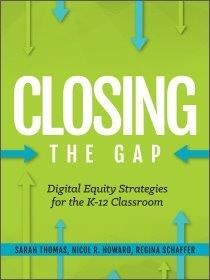Are There Ways to Close the Digital Divide for Students? New ISTE Book, Closing the Gap, Digital Equity Strategies for the K-12 Classroom, Provides Answers

WASHINGTON, D.C. – Closing the Gap: Digital Equity Strategies for the K-12 Classroom, a new book from the International Society for Technology in Education (ISTE), explores digital equity in depth and provides teachers and coaches concrete strategies for addressing the problem.
Authors Nicol R. Howard, Sarah Thomas and Regina Schaffer rely on this definition of digital equity: “Equal access and opportunity to digital tools, resources and services to increase digital knowledge, awareness, and skills.” Their book includes the latest research and approaches to digital equity challenges tied to the ISTE Standards for Educators and the ISTE Standards for Students. The book shares vignettes from teachers who have encountered and conquered some of these challenges, and from edtech coaches who have implemented equity-centered innovative professional development.
Research highlights the extent of the issue. A 2016 survey of 1,200 parents revealed that while 94 percent of families are connected to the internet, 23 percent access it on mobile devices, 26 percent share a single computer and 20 percent experienced loss of internet service due to lack of payment (Rideout & Katz, 2016). ACT’s Center for Equity in Learning also found that rural students were less likely than non-rural students to claim that their home internet access was “great” (36 percent vs. 46 percent).
- To combat the digital divide, teachers in today’s classrooms must address issues such as connectivity, limited resources and the homework gap. The book focuses on the following: How to resolve problems of practice, including assembling a team, identifying and analyzing the problem, and implementing a plan to attack barriers to digital equity.
- How teachers can help to promote digital equity, looking closely at three common themes: lifelong learning, communication and transforming learning.
- Professional learning, including questions for self-evaluation. The authors also discuss options for self-directed professional learning.
Closing the Gap is an ISTE book series designed to reflect the contributions of multiple stakeholders seeking to ensure that digital equity is achieved on campuses, in classrooms and throughout education. The first book in the series, Closing the Gap: Digital Equity Strategies for Teacher Prep Programs, shares examples and recommendations for educational technology leaders and educators on moving toward digital equity in K-12 and teacher education.
Nicol R. Howard, Ph.D., is an assistant professor in the School of Education at the University of Redlands in California. Her writing has appeared in the Corwin Connected Educators Series Standing in the Gap: Empowering New Teachers Through Connected Resources. Sarah Thomas, Ph.D., is an educator and the founder of the EduMatch movement, a project that empowers educators to make global connections across common areas of interest. Regina Schaffer is a technology specialist for the Middletown Township School District in New Jersey. She was recently named to the National School Board Association’s 20 to Watch.
# # #
The International Society for Technology in Education (ISTE) is a nonprofit organization that works with the global education community to accelerate the use of technology to solve tough problems and inspire innovation. Our worldwide network believes in the potential technology holds to transform teaching and learning.
ISTE sets a bold vision for education transformation through the ISTE Standards, a framework for students, educators, administrators, coaches and computer science educators to rethink education and create innovative learning environments. ISTE hosts the annual ISTE Conference & Expo, one of the world’s most influential edtech events. The organization’s professional learning offerings include online courses, professional networks, year-round academies, peer-reviewed journals and other publications. ISTE is also the leading publisher of books focused on technology in education. For more information or to become an ISTE member, visit iste.org. Subscribe to ISTE’s YouTube channel and connect with ISTE on Twitter, Facebook and LinkedIn.







